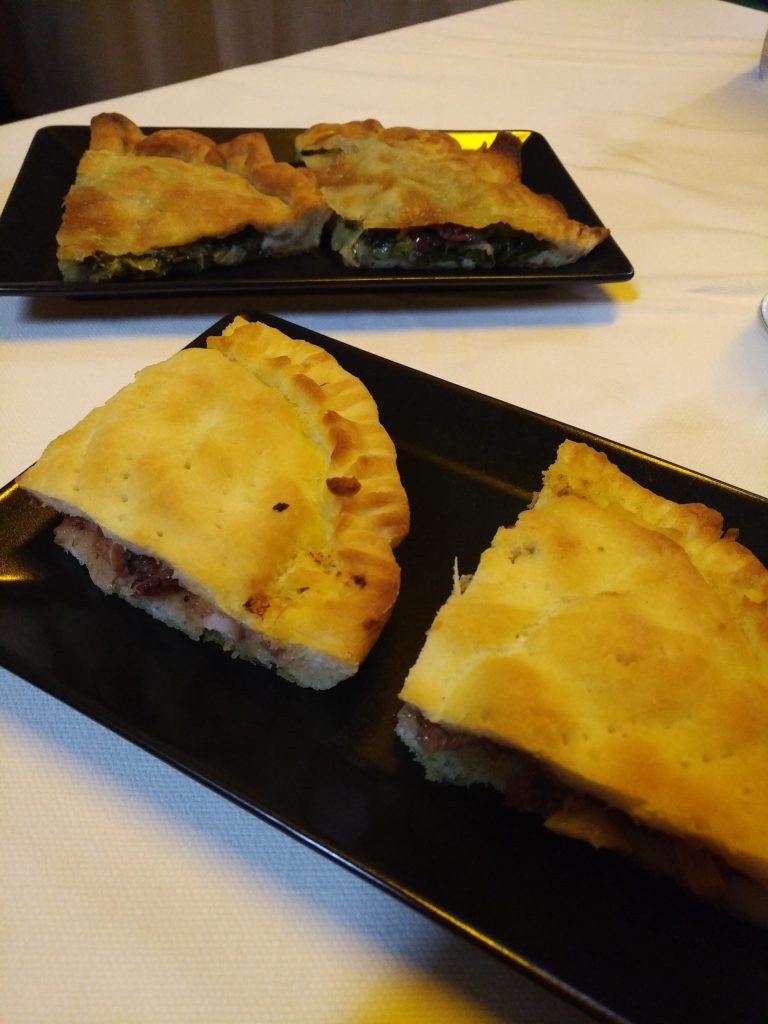During our trip to Gaeta, we couldn’t miss trying one of its most famous dishes: the pie.
At the restaurant “La Rete” I requested a gluten-free version that the kind owner prepared specifically for me: exceptional!
The Gaeta pie consists of a filling of various types (usually from land or sea products) between two sheets of dough similar to pizza.
The pie originated as a one-dish meal, favored by farmers and fishermen to allow them to have a dish that could be preserved for several days.
It is said that even during the Bourbon times some of them were admirers; later, its memory is linked to the consumption by Gaeta people who traveled to America to emigrate seeking fortune.
The tradition wants the pie filled with octopus, just like I tasted it, or calamari, escarole, as Stefano ate it (see photos of both below), spinach and salted cod, zucchini, onions, anchovies, sardines, mussels, or other options, according to variations.
It is said that the secret of a good pie is the oil produced with Gaeta olives which, as was said in the past, should run down the elbows.
The pie, according to tradition, should be placed in a baking pan (tiella, hence the name) made of tinned copper (which evenly distributes heat).
It is more of a street food than a real dish to enjoy in a restaurant, so the suggestion, if you want to eat it on a plate, there in Gaeta: book it at least one day in advance.
To best enjoy its softness and compactness, it should be eaten with hands, cut into wedges, letting the oil drip on the fingers.
Do not refrigerate. It keeps for a couple of days.
The following recipe is for the most representative pie, the one with octopus.
In the video, you will also find the gluten-free preparation, with buckwheat flour replacing the wheat flour.

- Difficulty: Medium
- Cost: Economical
- Rest time: 30 Minutes
- Preparation time: 10 Minutes
- Portions: 1 person
- Cooking methods: Oven
- Cuisine: Italian
- 2 cups flour
- 2 tsp yeast
- 7 oz water
- 1.1 lbs octopus
- 1.8 oz pitted black Gaeta olives
- 1.8 oz peeled tomatoes
- as needed parsley
- as needed chili peppers
- as needed olive oil
- as needed salt
Preparation
First, boil the octopus. Bring a pot with plenty of water and a pinch of salt to a boil, and immerse the octopus so that it is completely covered by the water
Let it boil for about 45 minutes over low heat, check the cooking from time to time, and remove any foam that may form.
Prepare the dough for the bases by placing the yeast with salt and oil in a bowl. Gradually add the flour and then the water until you get a homogeneous dough, kneading it for at least 10 minutes.
Wrap the dough in a cloth and let it rise for at least half an hour in a warm environment.
In the meantime, prepare the filling by cutting the octopus into pieces and seasoning them with oil, parsley, chili pepper, and peeled tomatoes, adding the pitted olives.
Take half of the dough and roll it out with a rolling pin until you get a sheet less than half an inch thick. Grease a round baking pan with oil and line it with the dough disk.
Place the filling on the dough and cover with a dough disk like the one prepared earlier, joining the two disks with a light pressure all around the edge. Close well by sealing the edges, prick the surface with the tines of a fork, and brush generously with olive oil.
Bake in a preheated oven on the lower level of the static oven at 356°F and cook for 30/35 minutes. Once cooked, remove from the oven and let it cool for a few minutes before serving.
*The black Gaeta olives:
The Gaeta olive is not black, as commonly believed, but purplish in color, with a winey, slightly bitter taste with acetic notes.
There are many imitations. The recognition for the Protected Geographical Indication is ongoing. The quality and species of the olives are important. The best result is obtained with the local “cultivar,” which is spindle-shaped. We also find the species nowadays called “itrana,” which has a more round fruit.
There are many imitations. The recognition for the Protected Geographical Indication is ongoing. The quality and species of the olives are important. The best result is obtained with the local “cultivar,” which is spindle-shaped. We also find the species nowadays called “itrana,” which has a more round fruit.
There are many imitations. The recognition for the Protected Geographical Indication is ongoing. The quality and species of the olives are important. The best result is obtained with the local “cultivar,” which is spindle-shaped. We also find the species nowadays called “itrana,” which has a more round fruit.

